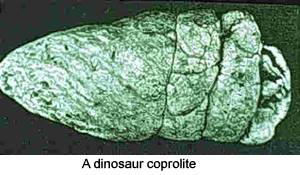BACKGROUND:
Some organisms leave information about their activities in rocks.
Paleontologists use these clues to recreate how the organisms may have
lived. These clues are called trace fossils. There are several main types of
trace fossils. Tracks and trails are produced by an organism walking,
crawling, foraging, or resting. Many dinosaur tracks tell us something about
how large the dinosaur was, how fast it walked, and who walked with it.
Burrows and borings are the tiny tunnels worms and other creatures make
as they move through the ground. Different types of burrows indicate
feeding, dwelling, or foraging behaviors.
Coprolites are fossilized animal
excrements. They help in determining the approximate structure of the
animals gut and may give some indication of the animals’ diet.
PROCEDURE:
- This activity has the students create their own "trace
fossil," by making a hand print. This hand print can provide
information, just like a dinosaur footprint provides information about
the lifestyle of dinosaurs. Tell the students that they are going to
make an imprint much like the way dinosaurs made footprints.
- Students should roll the playdough or clay into balls and flatten
it. Students should press their hands into the dough to make an imprint.
Let them compare their hand prints with their neighbors. Have them look
at the size, lines of the palm and other characteristics.
- Emphasize to students that they need to observe the differences very
carefully. Measuring and recording these differences is very important.
You may wish to ask them how their prints are similar to the dinosaur
footprints and how they are different.
- Give students the dinosaur models and have them make imprints of the
foot and skin of the dinosaurs. Make sure that footprints and skin
prints of each model are created. Students should then compare the
prints made by the different models. They should draw their findings on
the lab sheet. Students may notice differences between the models and
the animals in real life. Remind them that manufacturers of toys
sometimes do not create realistic models. Explain that this is a way of
getting information about a dinosaur without having a fossilized
skeleton. Many times paleontologists rely on only "trace
fossils."
PLAYDOUGH RECIPE #1 (dough formed is not as durable as recipe #2)
1 cup flour
1\2 cup salt
2 teaspoon cream of tartar
1 cup water
RECIPE #2. CLASSROOM QUANTITIES (alum helps preserve the
playdough)
5 cups of flour
1 cup of salt
2 tablespoons of alum
2 tablespoons oil
3 cups of very hot water
Both recipes need to be cooked over medium heat and stirred for 3-4
minutes until the dough forms a ball and separates from the sides of the
pan. You may add food coloring or glitter for special effects. For even
distribution, add the food coloring at the same time as the water.
In your kit you have a model of a Velociraptor,
Stegosaurus, Triceratops, Apatosaurus, Pachycephalosaurus,
Ankylosaurus, Parasaurolophus, Styracosaurus, Tyrannosaurus, Brachiosaurus,
and Edmontosaurus. Dimetrodon is in the collection but it is a mammal-like
reptile and not considered a dinosaur.Below is some information of the
dinosaurs.
Stegosaurus Extremely small skull about 16 inches, but was 24 feet
long, weighed about two tons, double row of large, bony plates with the largest
about two feet wide and two feet tall; end
of tail were foot long spikes covered in tough horn; back legs where twice as long as the front legs;
broad, three toed feet; front
feet had five strong clawed toes
Triceratops
long, sharp horns; bony frill around neck;
skull measured up to 7 feet, with two horns on the brow about 3 feet
long; short horn on nose about 7 inches; front
of mouth was a sharp beak; grinding
teeth in back; neck frill was solid
sheet of bone; was 30 feet long 10
feet tall, and 9 tons Long
hipbones were attached to a large number of vertebrate, making the body
stronger; walked on four legs, they
were all thick; on the feet there
were short wide toes; five in front and 4 in back
Parasaurolophus
Hollow, 1 meter long crest acted as a resonator,
producing a loud trumpeting noise. beak and toothed jaws
Brachiosaurus
52 teeth, large nasal opening at top of skull, 40-50 ft tall, 8.5 ft
long; 50-80 tons; 4 strong legs, 14
neck vertebra with longest being 3 feet long;
neck also have complicated joint system to help strengthened;
front legs were longer to support neck;
had small feet for its size, with front foot and first 3 digits of hind
foot with a claw; neck up to 20
feet long
Tyrannosaurus
about 40 feet long and 12 feet tall, could rear up on its hind legs and
reach 18 feet. It weighed 6-7 tons,
more than an elephant. It walked on
two legs and held its long tail straight out behind it which helped to balance.
The back legs were strong enough to support the body, including massive
angle bones. Each foot had four
toes, one small and three large ones. The
claws were large. The
arms and two clawed hands were small for its body and did not even reach its
mouth. It has special ribs that
were opposite the vertebrate. Massive
skull was nearly four feet long. 60
sharp teeth embedded in 3 foot jaws